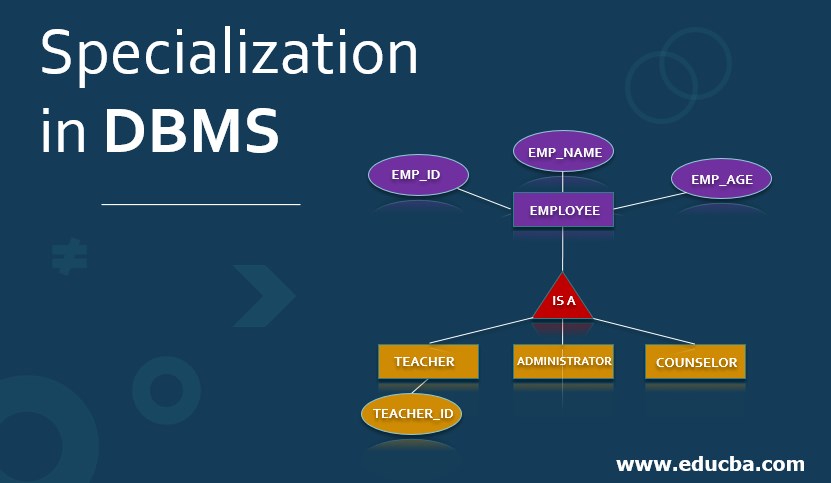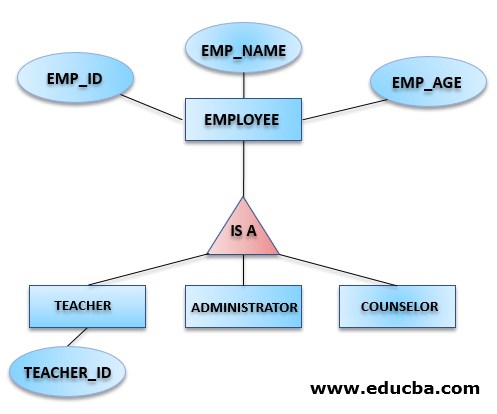Updated March 27, 2023

Introduction to Specialization in DBMS
An entity in a Database Management System (DBMS) can be defined as an object or thing in a real-world which can be distinguished from other object or thing and attributes are the properties of the entity. The Specialization in DBMS is further divided into sub-entities in Specialization. Specialization is a database abstraction mechanism that is used in order to distinguish the subset of an entity set which contains different characteristics.
Why do we need Specialization in DBMS?
The Entity-Relationship Model became more complex for larger databases and to avoid the inconvenience of such a situation, additional concepts such as Specialization, Generalization, and Aggregation was used. These additional concepts helped in reducing the complexity of the larger databases. The simplification mechanism which can be used to block out the redundant or excess of the details or characteristics of a set of objects is called Abstraction. The interesting properties of the application can be properly studied by the usage of abstraction. Specialization is one such abstraction mechanism.
Data abstraction helps in concealing the extra details such as data storage, organization and definition from the users and only exposing the necessary details for their usage. The higher-level entities are broken into two or more lower-level entities in Specialization. Specialization is termed as the top-down approach whereas Generalization is opposite to it where two entities are combined together to form a higher-level entity.
Working of Specialization in DBMS
The working of specialization in DBMS are as follows.
The Database structures are created from complex data structures. In the concept of data abstraction, the unnecessary details of the database are hidden away from the user and only the developers have the knowledge of such details. We can take the example of an online shopping database where the order details are stored in table ORDERS. The complex concepts such as how the data is stored in the table etc. are only known to the developers who possess a thorough knowledge of the Database Management System. But the users only interact with the system with the help of a graphical user interface at the view level and they do not have enough knowledge of the Database components to understand the process in which the data gets stored and these details are concealed from them.
We can interpret Specialization as a process where a set of subclasses of the entity type are defined and the entity type is called the superclass of Specialization. Based on the distinguishing characteristics of the entities in the superclass, the set of subclasses which creates the Specialization are defined. The higher-level entities are further classified into lower-level entities in Specialization which can be defined as the top-down approach. In specialization, new characteristics to an existing class of objects are introduced in order to create new classes of objects. Specialization takes up a higher-level entity and then gives rise to lower-level entities by the usage of extra or added characteristics. The characteristics of the higher-level entities are also inherited by the lower-level entities.
Example (Explain with ER Diagram)
A collection of basic objects i.e. entities and the relationship among them are used in the E-R or Entity-Relationship data model. With the help of the Entity-Relationship diagram, the comprehensive logical structure of the database can be drawn. The aim of Specialization is to classify the subsets of the entities which contain differentiating attributes. In the below example, in the Entity-Relationship diagram, we can see that the entity EMPLOYEE is further classified into various sub-entities.
[Specialization]
From the above Entity-Relationship diagram, it is visible that EMPLOYEE is a higher-level entity that is further classified into sub-entities such as TEACHER, ADMINISTRATOR, and COUNSELOR. The above-stated sub-entities are the employees in an organization, for example, a School. The different employees though belong to the same organization but their roles are different from each other. Also, sub-entities may have different attributes. Here we can see that the sub-entity TEACHER has the attribute TEACHER_ID which can be used to identify different teachers in the organization. The sub-entities are the three different types of employees working in the School and they have common attributes such as EMP_ID, EMP_NAME, and EMP_AGE which are related to the parent entity EMPLOYEE.
Importance of Specialization in DBMS
Specialization helps in defining the set of subclasses of the entity type. Also, it helps in establishing extra specific attributes with all subclasses and added specific relationship types between each subclass and the other entity types or the other subclasses. One of the chief goals of inclusion of Specialization in a data model is that certain attributes may only be applicable to a few entities of the superclass but not to all. In order to group the entities to which these attributes are applicable, a subclass is defined. A large number of the attributes of the members of the subclass may still be shared with other members of the superclass.
Conclusion
Specialization plays a vital role in a Database Management System with an increase in size as well as the level of complexity of databases. It is important for developers to have a keen understanding of this concept.
Recommended Articles
This is a guide to Specialization in DBMS. Here we discuss the introduction, Why do we need Specialization in DBMS, Working, and Importance of DBMS. You can also go through our other related articles to learn more–

